Antiochus Cylinder
The Cylinder of Antiochus I Soter from the Ezida Temple in Borsippa is one of the Mesopotamian chronicles written in ancient Babylonia in the Hellenistic Period. It describes how the Seleucid crown prince Antiochus, the son of king Seleucus Nicator, rebuilt the Ezida Temple and prays for divine protection. For a very brief introduction to the literary genre of chronicles, go here.
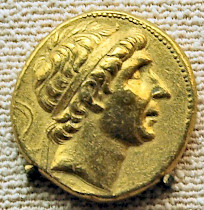
The Antiochus Cylinder describes how the Seleucid crown prince Antiochus, the son of king Seleucus Nicator, rebuilt the Ezida Temple in Borsippa and prays for divine protection. The cuneiform text itself (BM 36277) is now in the British Museum.
On this webpage, a new reading is proposed; the official publication will be in I.L. Finkel, R.J. van der Spek, R. Pirngruber, Babylonian Chronographic Texts from the Hellenistic Period (2020; = BCHP; Writings of the Ancient World).
Previous editions
Copies:
- Strassmaier, J.N. 1882, Verhandlungen des 5. Internationalen Orientalistenkongresses II.1 (Berlin), Beilage zu I 14: 139ff.
- V R 66 = Pinches, Th.G. 1884, The Cuneiform Inscriptions of Western Asia, Vol. V (London) no. 66; his drawing can be found here.
Transliterations and translations:
- Weissbach, F.H. 1911, Die Keilinschriften der Achämeniden, VAB 3 (Leipzig) 132-5
- Kuhrt, A. & Sherwin-White, S. 1991, ‘Aspects of Seleucid royal ideology: the cylinder of Antiochus I from Borsippa’, Journal of Hellenic Studies 111, 71-86.
Translations only:
- ANET3 = Pritchard, J.B. 1969, Ancient Near Eastern Texts relating to the Old Testament (Princeton) 317 (translation A.L. Oppenheim); also in: M.M. Austin 1981, The Hellenistic World from Alexander to the Roman conquest. A Selection of Ancient sources in translation (Cambridge) 310-1, no. 189.
- Falkenstein, A. & Von Soden, W. 1953, Sumerische und akkadische Hymnen und Gebete (Zürich) 291-2, no. 38 (I 16 - II 29).
- Foster, B.R. 1993, Before the Muses II (Bethesda) 759; 2nd ed. (1996) II 744; 3rd edition (2005) 866. Translation of I 16 - II 29, ‘Prayer to Nabû.’
- Seux, M.-J. 1976, Hymnes et prières aux dieux de Babylonie et d’Assyrie (Paris) 525-6 (I 16 – II 29)
- Stevens, K. 2012, "Collations to the Antiochus Cylinder (BM 36277)", in: Nouvelles Assyriologiques Brèves et Utilitaires (NABU) 2012, p.46-7, no. 35
- Stevens, K. 2014, "The Antiochus Cylinder, Babylonian Scholarship, and Seleucid Imperial Ideology" in Journal of Hellenic Studies 134, 66-88.
Description of the Cylinder
The document is a barrel-shaped clay cylinder, which had been buried in the foundations of the Ezida Temple in Borsippa. This form of foundation document is found in considerable quantities since the second millennium BCE. The script of this cylinder is deliberately archaising. It is inscribed in archaic ceremonial Babylonian cuneiform script that was used in the well-known Codex of Hammurabi and adopted in a number of royal inscriptions of Neo-Babylonian kings, esp. Nabopolassar, but also Nebuchadnezzar and Nabonidus. The script is quite different from the cuneiform script that was used for chronicles, diaries, rituals, scientific and administrative texts.
The Antiochus cylinder is the latest one extant. Another late example is the Cyrus Cylinder, commemorating Cyrus' capture of Babylon in 539 BCE. This cylinder, however, was written in normal Neo-Babylonian script.
The Antiochus Cylinder was found by Hormuzd Rassam in 1880 in Ezida, the temple of the god Nabû in Borsippa, in what must have been its original position "encased in some kiln-burnt bricks covered over with bitumen," in the "doorway" of Koldewey's Room A1: probably this was built into the eastern section of the wall between A1 and Court A, since the men of Daud Thoma, the chief foreman, seem to have destroyed much of the brickwork at this point. Rassam mistakenly records this as a cylinder of Nebuchadnezzar II.
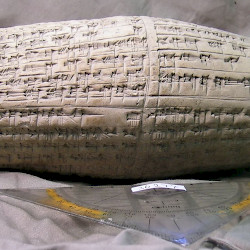 Antiochus Cylinder |
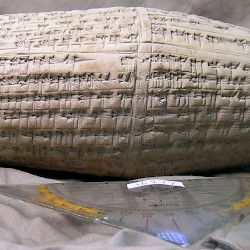 Antiochus Cylinder |
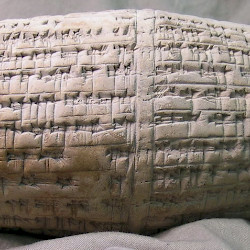 Antiochus Cylinder |
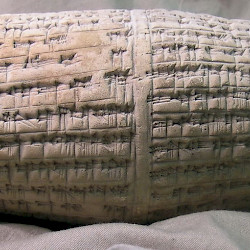 Antiochus Cylinder |
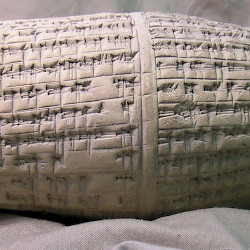 Antiochus Cylinder |
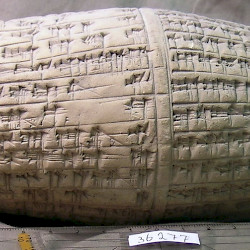 Antiochus Cylinder |
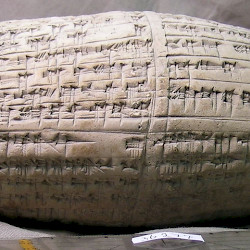 Antiochus Cylinder |
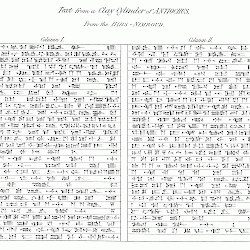 Antiochus Cylinder (Drawing by Pinches) |
General Commentary
Antiochus I Soter (c.324-261 BCE) was the eldest son of Seleucus I Nicator and the Bactrian princess Apame. He became co-ruler with his father in 294 and at the same time married his father's second wife, Stratonice I (daughter of Demetrius Poliorcetes, whom his father had married in 298).
The last record of Seleucus as sole king is MLC 2654note on 9.II.17 SE = 13 May 295; the first tablet dated to both Seleucus and Antiochus is BM 109941 1.VIII.18 SE = 18 November 294.note The name of the queen is preserved in the Antiochus cylinder as Astartanikku (fAs-ta-ar-ta-ni-ik-ku, ii 26), perhaps a word play on Astarte. The news of her death in Sardes is recorded in Astronomical Diary no. -253 A110; A23 ([fAs-t]a-rat-ni-qé-e), Sep/Oct 254.
Antiochus was put in charge of the so-called upper satrapies, including Mesopotamia and Babylonia. Thanks to the Babylonian chronicles we have a great deal of information about his actions in Babylon. He probably lived for a considerable time in the palace in Babylon, while the new royal city Seleucia on the Tigris was being built. Antiochus is called "crown prince" in the Antiochus and Sin Chronicle,note settling Macedonians from Babylon in Seleucia and making offerings in two temples of Sin (Egišnugal and Enitenna). The Ruin of the Esagila Chronicle (BCHP 6) is illuminating for Antiochus' interest in the rebuilding of Esagila. He used elephants and wagons for the clearing of the site of Esagila, apparently the temple tower Etemenanki (cf. Van der Spek 2005a). The Antiochus, Bactria, and India Chronicle (BCHP 7 = ABC 13A) and the Juniper Garden Chronicle (BCHP 8) probably also date to this period.
King Seleucus meanwhile turned his attention to the west. In 281 he defeated Lysimachus, king of Thrace and western parts of Asia Minor, at Corupedium in Asia Minor, so that he acquired the greater part of this region. But Seleucus apparently wanted more: he took the opportunity to try to return to his homeland, perhaps because he was homesick.note He crossed the Hellespont, but was murdered by Ptolemy Keraunos, the son of King Ptolemy I Soter of Egypt, who, when in disgrace, had sought refuge with Seleucus. The last months of Seleucus are treated in the End of Seleucus Chronicle (ABC 12 = BCHP 9). The murder is also mentioned in the Babylonian King List of the Hellenistic Periodnote "in the land of Hanî" in month VI of year 31 SE (26 August-24 September 281).
Antiochus' first great exploit as sole king (r.281-261) was his defeat of the Galatians, who had invaded Asia Minor, in the 'Battle of the Elephants' (275) and penned them in beyond the Halys (Galatia). 274-271 he fought the First Syrian War with Ptolemy II Philadelphus (283-246), partly described in an Astronomical Diary.note The diary mentions how troops were levied and resources gathered in Babylonia, elephants moved from Bactria through the province; so much silver was collected that exchanges were paid in Greek bronze coins. Citizens of Babylon were summoned to Seleucia on the Tigris to receive orders concerning taxation and land policy. This information has been linked with the later classical report that citizens of Babylon were deported to Seleucia,note but the new readings of Sachs and Hunger have made this interpretation untenable.note Land that was given to the Babylonians in Antiochus' first year was now confiscated again or made subject to royal taxation.note
The end of the war is only tentatively dated at 271 BC by Édouard Will.note In 271/0 BC (SEB 41) the king was encamped in Syria.note Not much is known about the end of Antiochus' reign. In 268 BC he was in Babylon, as this cylinder testifies.
Introduction
[i.1] Antiochus, the great king,
[i.2] the mighty king, king of the world, king of Babylon, king of (all) countries,
[i.3] caretaker of Esagila and Ezida,
[i.4] foremost son of Seleucus, the king,
[i.5] the Macedonian, king of Babylon,
[i.6] am I.
Antiochus Rebuilds Ezida
When I desired8 to build
[i.7] Esagila and Ezida,
[i.8] the (first) bricks
[i.9] of Esagila and Ezida
[i.10] in the land of Hatti with my pure hand(s)
[i.11] I moulded with fine quality oil and
[i.12] for the laying of the foundation of Esagila
[i.13] and Ezida I transported them. In the month of Addaru, on the 20th day,
[i.14] of year 43,note I laid16 the foundation of Ezida,
[i.15] the true temple, the temple of Nabû, which is in Borsippa.
Antiochus' Prayer
[i.16] O Nabû, lofty son,
[i.17] the wise one of the gods, the proud one,
[i.18] who is eminently worthy19 of praise,
[i.19] firstborn son
[i.20] of Marduk, offspring of Erûa
[i.21] the queen, who creates offspring,
[i.22] regard me joyfully and,
[i.23] at your lofty command
[i.24] which is unchanging,
[i.25] may the overthrow of the country of my enemy,note
[i.26] the achievement of my triumphs,
[i.27] the predominance over the enemy through victory,
[i.28] kingship of justice, a reign
[i.29] of prosperity, years of happiness,
[i.30] (and) the full enjoyment of very old age be the gift
[ii.1] for the kingship of Antiochus
[ii.2] and king Seleucus, his son,
[ii.3] for ever. O Son of the Prince (Marduk),
[ii.4] Nabû, son of Esagila,
[ii.5] first-born son of Marduk,
[ii.6] offspring of queen Erûa:
[ii.7] at your entry10 into Ezida, the true house,
[ii.8] the house of your Anu-ship, the dwelling of your heart's desire,
[ii.9] with rejoicing and jubilation,
[ii.10] may - at your true11 command,
[ii.11] which cannot be annulled - my days be long,
[ii.12] my years many,
[ii.13] may my throne be secure, my reign long-lasting,
[ii.14] on your sublime writing board
[ii.15] which sets the boundary of heaven and earth.
[ii.16] May my good (fate)17 constantly be established in your pure mouth,
[ii.17] may my hands19 conquer18 the countries from sunrise
[ii.18] to sunset
[ii.19] that I might inventory their tribute
[ii.20] and bring21 it to make perfect Esagila
[ii.21] and Ezida. O Nabû,
[ii.22] foremost son, when you enter23 Ezida,
[ii.23] the true house,
[ii.24] may good (fate) for Antiochus, king of (all) countries,
[ii.25] king Seleucus, his son,
[ii.26] (and) Stratonice,
[ii.27] his consort, the queen,
[ii.28] may their good (fate),
[ii.29] be established by your command (lit: in/by your mouth).